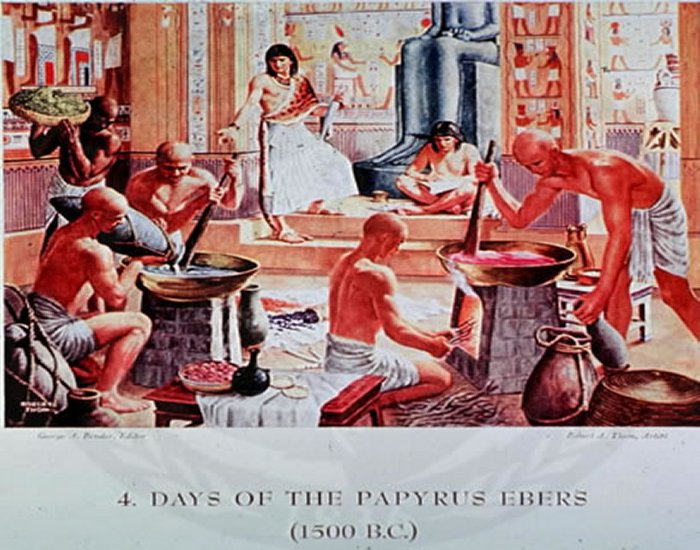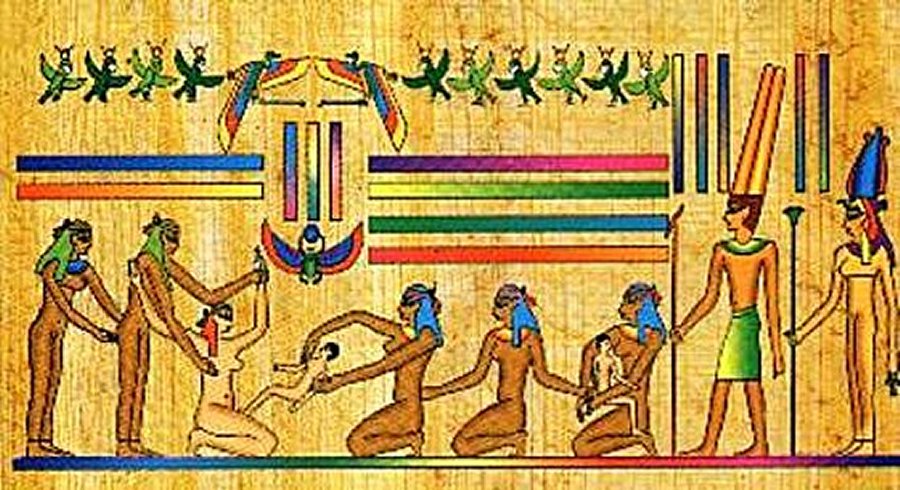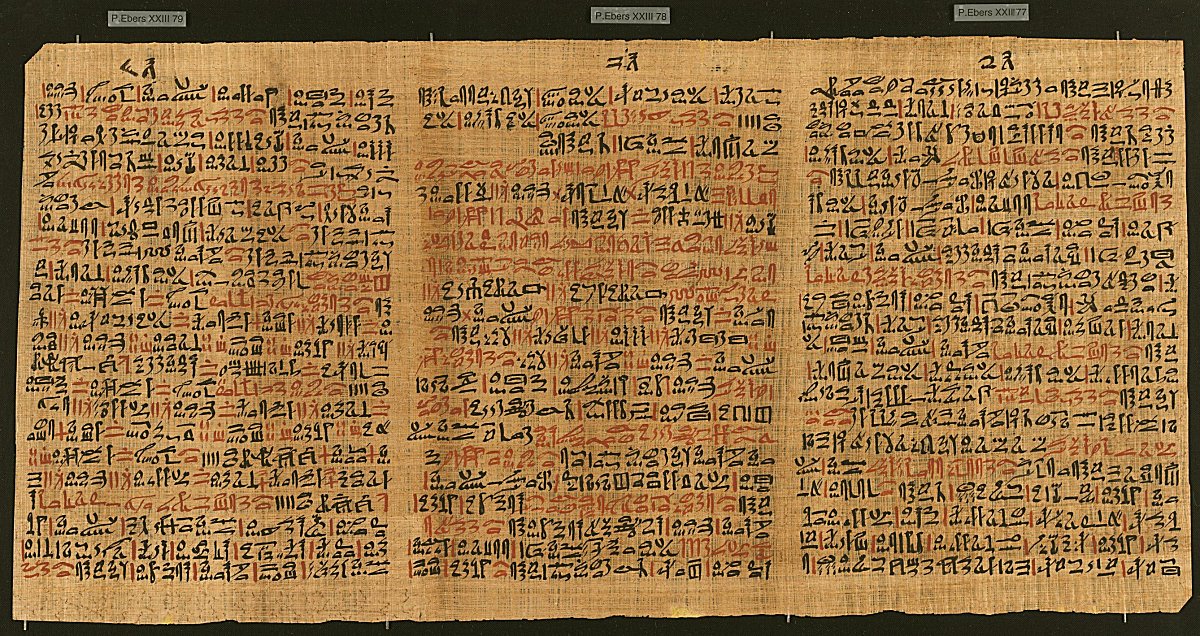The Ebers Papyrus – Most Famous Plant Medicine ‘Encyclopedia’ Of Ancient Egypt
A. Sutherland - AncientPages.com - Herbal medicine was considered complementary medicine in ancient Egypt and it played a key role in society. Ancient Egyptian scrolls document natural herbs and holistic medicine that saved lives and cured disease.
Evidence comes from burial sites, tombs, and underground temples where archeologists have found extensive sets of medical documents and scrolls, including the Ebers Papyrus.
The Ebers Papyrus – the most famous plant – medicine “encyclopedia” – is among several other ancient medical scrolls. A 110-page scroll, which rolls out to be about 20 meters long was found between the legs of a mummy in the Assassif district of the Theben necropolis. Photo: via Naturale clinic
The Ebers Papyrus – the most famous plant – medicine “encyclopedia” – is among several other ancient medical scrolls.
A 110-page scroll, which rolls out to be 20.23 meters in length and 30 centimeters in height, was found between the legs of a mummy in the Assassif district of the Theben necropolis.
It is unclear who the seller was, but the document was purchased in Luxor by Edwin Smith in 1862 and remained in his collection until at least 1869 when there appeared, in the catalog of an antiquities dealer, an advertisement for “a large medical papyrus in the possession of Edwin Smith, an American farmer of Luxor.”
Ten years later, the Papyrus was purchased in 1872 by the Egyptologist George Ebers, for who it is named. In 1875, Ebers published a facsimile with an English-Latin vocabulary and introduction.
This particular reference to the Lower Egyptian Den suggests its origin closer to the First Dynasty (c. 3000 B.C.E.)
The Ebers Papyrus is by far the most lengthy of the medical papyri and it is dated to the 9th year of the reign of Amenhotep I (c. 1534 B.C.E.).
However, it is believed to have been copied from earlier texts or it could be much older because paragraph 856a states that: “the book of driving wekhedu from all the limbs of a man was found in writings under the two feet of Anubis in Letopolis and was brought to the majesty of the king of Upper and Lower Egypt Den.”(Nunn 1996: 31)
The Ebers Papyrus contains magical spells designed to protect from supernatural intervention on diagnosis and treatment. There is also a large section describing different diseases of the stomach, intestinal parasites, skin and eye diseases and diseases of the anus, and many more.
It describes several treatments and is full of prescribed remedies along with a large list of prescriptions to relieve medical ailments.
Several paragraphs contain remedies that are believed to have been made and used personally by various deities; in paragraph 247, for example, there is a note relating to Isis’ creation of a remedy for an illness in Ra’s head, and the document mentions a specific diagnosis.
Here are some remedies from the ancient Ebers Papyrus scrolls:
Aloe vera was used to alleviate burns, ulcers, skin diseases, and allergies
– Basil was written up as heart medicine
– Balsam Apple (Apple of Jerusalem) was used as a laxative and as a liver stimulant
– Bayberry was prescribed for diarrhea, ulcers, and hemorrhoids
– Caraway soothed digestion and was a breath freshener
– Colchicum (citrullus colocynthus or meadow saffron) soothed rheumatism and reduced swelling
– Dill was recognized for laxative and diuretic properties
– Fenugreek was prescribed for respiratory disorders and to cleanse the stomach and calm the liver and pancreas
– Frankincense was used for throat and larynx infections, and to stop bleeding and vomiting
– Garlic was given to the Hebrew slaves daily to give them vitality and strength for building the pyramids
– Licorice was utilized as a mild laxative, to expel phlegm, and to alleviate chest and respiratory problems
– Onion was taken to prevent colds and to address cardiovascular problems (How did they know?)
– Parsley was prescribed as a diuretic
– Thyme was given as a pain reliever and Tumeric for open wounds
– Poppy was used to relieve insomnia, as an anesthetic, and to kill the pain
– Coriander was taken as a tea for urinary complaints, including cystitis
– Pomegranate root was strained with water and drunk to address “snakes of the belly” (tapeworms). The alkaloids contained in pomegranate paralyzed the worms’ nervous system and they relinquished their hold.
– Persian henna was used against hair loss
The papyrus also covers subjects such as dementia, depression, and contains chapters on the diagnosis of pregnancy, several different gynecological matters, contraception, dentistry, and the surgical treatment of burns, tumors, and bone-setting. There is also described the treatment of migraines.
The Ebers Papyrus is currently kept at the library of the University of Leipzig, in Germany.
Written by – A. Sutherland - AncientPages.com Senior Staff Writer
Copyright © AncientPages.com All rights reserved. This material may not be published, broadcast, rewritten or redistributed in whole or part without the express written permission of AncientPages.com
Expand for referencesMore From Ancient Pages
-
 Ancient Round Coins Were Invented To Prevent Fraud
Ancient History Facts | Mar 21, 2018
Ancient Round Coins Were Invented To Prevent Fraud
Ancient History Facts | Mar 21, 2018 -
 Remarkable South-Pointing Chariot – Ancient Cybernetic Machine Invented 1,700 Years Ago Is An Engineering Masterpiece
Ancient Technology | Jul 17, 2014
Remarkable South-Pointing Chariot – Ancient Cybernetic Machine Invented 1,700 Years Ago Is An Engineering Masterpiece
Ancient Technology | Jul 17, 2014 -
 Mama Quilla – Incan Moon Goddess Of Marriage And Fertility Assisted By High Priestesses Of Qoricancha
Featured Stories | Jun 15, 2020
Mama Quilla – Incan Moon Goddess Of Marriage And Fertility Assisted By High Priestesses Of Qoricancha
Featured Stories | Jun 15, 2020 -
 How Did Ancient People Wake Up On Time Before The Alarm Clock Was Invented?
Ancient History Facts | Jan 4, 2021
How Did Ancient People Wake Up On Time Before The Alarm Clock Was Invented?
Ancient History Facts | Jan 4, 2021 -
 Katanga Cross: Symbol Of Secrets, Power And Valuable Currency Of The Congolese People
Ancient Symbols | Sep 10, 2018
Katanga Cross: Symbol Of Secrets, Power And Valuable Currency Of The Congolese People
Ancient Symbols | Sep 10, 2018 -
 Ancient Mystery Of The Before – Time People – Traces Of An Unknown Lost Race – Part 1
Civilizations | Apr 3, 2019
Ancient Mystery Of The Before – Time People – Traces Of An Unknown Lost Race – Part 1
Civilizations | Apr 3, 2019 -
 Scientific Disagreement Over The Bronze Age Tin Ingots From The Uluburun Shipwreck
Archaeology | Sep 25, 2023
Scientific Disagreement Over The Bronze Age Tin Ingots From The Uluburun Shipwreck
Archaeology | Sep 25, 2023 -
 Lost Medieval Home Of The Lords Of The Isles – Reconstructed Virtually
Archaeology | May 29, 2019
Lost Medieval Home Of The Lords Of The Isles – Reconstructed Virtually
Archaeology | May 29, 2019 -
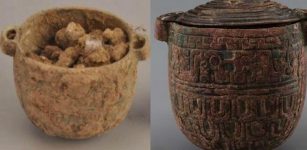 2,700-Year-Old Face Cream For Men Found In Chinese Tomb
Archaeology | Feb 10, 2021
2,700-Year-Old Face Cream For Men Found In Chinese Tomb
Archaeology | Feb 10, 2021 -
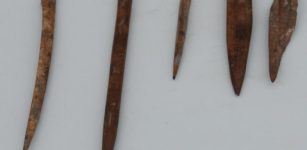 8,200-Year-Old Needles Unearthed In Turkey’s Izmir
Archaeology | Jul 13, 2022
8,200-Year-Old Needles Unearthed In Turkey’s Izmir
Archaeology | Jul 13, 2022 -
 12,000-Year-Old Crater Dipsiz (‘Bottomless’) Lake, Searched For Gold, And Destroyed In Legal But Controversial Excavation
Archaeology | Nov 17, 2019
12,000-Year-Old Crater Dipsiz (‘Bottomless’) Lake, Searched For Gold, And Destroyed In Legal But Controversial Excavation
Archaeology | Nov 17, 2019 -
 The Name Vatican And Etruscan Goddess Vatika Of The Underworld – What Is The Connection?
Featured Stories | Jun 6, 2020
The Name Vatican And Etruscan Goddess Vatika Of The Underworld – What Is The Connection?
Featured Stories | Jun 6, 2020 -
 Neanderthals Vanishing When Homo Sapiens Emerged In Europe Was Coincidental – Are Herbivores The Answer?
Evolution | Sep 29, 2023
Neanderthals Vanishing When Homo Sapiens Emerged In Europe Was Coincidental – Are Herbivores The Answer?
Evolution | Sep 29, 2023 -
 Magnificent St. Paul’s Catacombs – Largest Underground Roman Cemetery In Malta
Featured Stories | Aug 28, 2019
Magnificent St. Paul’s Catacombs – Largest Underground Roman Cemetery In Malta
Featured Stories | Aug 28, 2019 -
 Rare ‘Polishing Boulder’ Used By Stone Age People Found In Dorset, UK
Archaeology | Aug 26, 2023
Rare ‘Polishing Boulder’ Used By Stone Age People Found In Dorset, UK
Archaeology | Aug 26, 2023 -
 Human Footprints Dating Back 800,000 Years Discovered In Norfolk UK
Archaeology | Feb 7, 2014
Human Footprints Dating Back 800,000 Years Discovered In Norfolk UK
Archaeology | Feb 7, 2014 -
 Are Priceless Ancient Gold Tablets Of The Serpent People Hidden Underground In Los Angeles?
Artifacts | May 24, 2014
Are Priceless Ancient Gold Tablets Of The Serpent People Hidden Underground In Los Angeles?
Artifacts | May 24, 2014 -
 Ancient Mysteries Of Arizona – Traces Of A Vanished Race And Secrets Of An Underground World
Civilizations | Mar 12, 2019
Ancient Mysteries Of Arizona – Traces Of A Vanished Race And Secrets Of An Underground World
Civilizations | Mar 12, 2019 -
 Mysterious Etruscans: Skilled Sailors And Master Craftsmen
Civilizations | Mar 1, 2016
Mysterious Etruscans: Skilled Sailors And Master Craftsmen
Civilizations | Mar 1, 2016 -
 Remarkable Ancient Windcatchers: Air Conditioning Systems Built Since Antiquity
Ancient Technology | Sep 3, 2016
Remarkable Ancient Windcatchers: Air Conditioning Systems Built Since Antiquity
Ancient Technology | Sep 3, 2016

